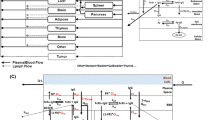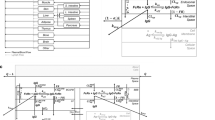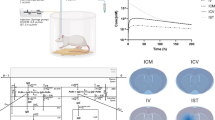Abstract
In this manuscript, we present a translational physiologically-based pharmacokinetic (PBPK) model to characterize receptor-mediated transcytosis (RMT) of anti-transferrin receptor (TfR) monoclonal antibodies (mAbs) in the central nervous system (CNS). The model accounts for the state-of-the-art knowledge of the brain's anatomy and physiology, and physiological parameters were fixed according to different species. By estimating a few parameters associated with the TfR concentration, the TfR turnover, and the internalization rate, the model simultaneously characterizes plasma, whole brain, interstitial fluid (ISF), and cerebrospinal fluid (CSF) PK of unbound and bound anti-TfR mAbs with different binding affinities in mice, rats, and monkeys obtained from various literature sources within a threefold prediction error. The final PBPK model was validated using external anti-TfR mAb PK data in mice and monkeys with different affinities and doses. The simulation reasonably predicted plasma and brain PK of monovalent/bivalent anti-TfR mAbs within a threefold prediction error and characterized a bell-shaped relationship between the brain ISF/plasma AUC ratio and the KD value. Although further refinements of the PBPK model and clinical validation are required, this PBPK model may provide physiologically-based translation of CNS disposition of anti-TfR mAbs by accounting for the physiological difference of the endogenous RMT system among different species. The PBPK model may also guide selection of other endogenous receptors, lead optimization, and clinical development of novel CNS-targeted mAbs.










Similar content being viewed by others
Abbreviations
- %PE:
-
Percentage of prediction error
- BBB:
-
Blood–brain barrier
- BCSFB:
-
Blood-CSF barrier
- CM:
-
Cisterna magna
- CNS:
-
Central nervous system
- CSF:
-
Cerebrospinal fluid
- CSF_CM:
-
CSF at the CM
- CSF_LV:
-
CSF at the LV
- CSF_SAS:
-
CSF at the SAS
- ECL:
-
Ependymal cellular layer
- FcRn:
-
The neonatal Fc receptor
- GSA:
-
Global sensitivity analysis
- hTfRMAB:
-
Humanized anti-TfR mAb
- ICV:
-
Intracerebroventricular
- IgG:
-
Immunoglobulin G
- ISF:
-
Interstitial fluid
- KD :
-
The dissociation constant
- LS:
-
Lumbar spine
- LV:
-
Lateral ventricles
- mAbs:
-
Monoclonal antibodies
- PBPK:
-
Physiologically-based pharmacokinetic
- PK:
-
Pharmacokinetics
- PVS:
-
Perivascular space
- RMT:
-
Receptor-mediated transcytosis
- SA:
-
Surface Area
- SAS:
-
Subarachnoid space
- ST:
-
Striatum
- SV-ARBEC:
-
SV40-immortalized adult rat brain endothelial cells
- Tf:
-
Transferrin
- TfR:
-
Transferrin receptor
- TFV:
-
Third-fourth ventricles
- TMDD:
-
Target-mediated drug disposition
References
Vendel E, Rottschafer V, de Lange ECM (2019) The need for mathematical modelling of spatial drug distribution within the brain. Fluids Barriers CNS 16(1):12
Pardridge WM (2019) Alzheimer’s disease: future drug development and the blood-brain barrier. Expert Opin Investig Drugs 28(7):569–572
Wang Q, Delva L, Weinreb PH, Pepinsky RB, Graham D, Veizaj E, Cheung AE, Chen W, Nestorov I, Rohde E, Caputo R, Kuesters GM, Bohnert T, Gan LS (2018) Monoclonal antibody exposure in rat and cynomolgus monkey cerebrospinal fluid following systemic administration. Fluids Barriers CNS 15(1):10
Yadav DB, Maloney JA, Wildsmith KR, Fuji RN, Meilandt WJ, Solanoy H, Lu Y, Peng K, Wilson B, Chan P, Gadkar K, Kosky A, Goo M, Daugherty A, Couch JA, Keene T, Hayes K, Nikolas LJ, Lane D, Switzer R, Adams E, Watts RJ, Scearce-Levie K, Prabhu S, Shafer L, Thakker DR, Hildebrand K, Atwal JK (2017) Widespread brain distribution and activity following icv infusion of anti-beta-secretase (BACE1) in nonhuman primates. Br J Pharmacol 174(22):4173–4185
Pizzo ME, Wolak DJ, Kumar NN, Brunette E, Brunnquell CL, Hannocks MJ, Abbott NJ, Meyerand ME, Sorokin L, Stanimirovic DB, Thorne RG (2018) Intrathecal antibody distribution in the rat brain: surface diffusion, perivascular transport and osmotic enhancement of delivery. J Physiol 596(3):445–475
Wolak DJ, Pizzo ME, Thorne RG (2015) Probing the extracellular diffusion of antibodies in brain using in vivo integrative optical imaging and ex vivo fluorescence imaging. J Control Release 197:78–86
Moos T, Morgan EH (2001) Restricted transport of anti-transferrin receptor antibody (OX26) through the blood-brain barrier in the rat. J Neurochem 79(1):119–129
Pardridge WM, Buciak JL, Friden PM (1991) Selective transport of an anti-transferrin receptor antibody through the blood-brain barrier in vivo. J Pharmacol Exp Ther 259(1):66–70
Yu YJ, Zhang Y, Kenrick M, Hoyte K, Luk W, Lu Y, Atwal J, Elliott JM, Prabhu S, Watts RJ, Dennis MS (2011) Boosting brain uptake of a therapeutic antibody by reducing its affinity for a transcytosis target. Sci Transl Med. 3(84):84ra44
Pepinsky RB, Shao Z, Ji B, Wang Q, Meng G, Walus L, Lee X, Hu Y, Graff C, Garber E, Meier W, Mi S (2011) Exposure levels of anti-LINGO-1 Li81 antibody in the central nervous system and dose-efficacy relationships in rat spinal cord remyelination models after systemic administration. J Pharmacol Exp Ther 339(2):519–529
Chang HY, Morrow K, Bonacquisti E, Zhang W, Shah DK (2018) Antibody pharmacokinetics in rat brain determined using microdialysis. MAbs 10(6):843–853
Yamamoto Y, Valitalo PA, van den Berg DJ, Hartman R, van den Brink W, Wong YC, Huntjens DR, Proost JH, Vermeulen A, Krauwinkel W, Bakshi S, Aranzana-Climent V, Marchand S, Dahyot-Fizelier C, Couet W, Danhof M, van Hasselt JG, de Lange EC (2017) A Generic multi-compartmental CNS distribution model structure for 9 drugs allows prediction of human brain target site concentrations. Pharm Res 34(2):333–351
Chang HY, Wu S, Meno-Tetang G, Shah DK (2019) A translational platform PBPK model for antibody disposition in the brain. J Pharmacokinet Pharmacodyn 46(4):319–338
Bloomingdale P, Bakshi S, Maass C, van Maanen E, Pichardo-Almarza C, Yadav DB, van der Graaf P, Mehrotra N (2021) Minimal brain PBPK model to support the preclinical and clinical development of antibody therapeutics for CNS diseases. J Pharmacokinet Pharmacodyn 48:861–871
Fishman JB, Rubin JB, Handrahan JV, Connor JR, Fine RE (1987) Receptor-mediated transcytosis of transferrin across the blood-brain barrier. J Neurosci Res 18(2):299–304
Lajoie JM, Shusta EV (2015) Targeting receptor-mediated transport for delivery of biologics across the blood-brain barrier. Annu Rev Pharmacol Toxicol 55:613–631
Smith MW, Gumbleton M (2006) Endocytosis at the blood-brain barrier: from basic understanding to drug delivery strategies. J Drug Target 14(4):191–214
Gadkar K, Yadav DB, Zuchero JY, Couch JA, Kanodia J, Kenrick MK, Atwal JK, Dennis MS, Prabhu S, Watts RJ, Joseph SB, Ramanujan S (2016) Mathematical PKPD and safety model of bispecific TfR/BACE1 antibodies for the optimization of antibody uptake in brain. Eur J Pharm Biopharm 101:53–61
Kanodia JS, Gadkar K, Bumbaca D, Zhang Y, Tong RK, Luk W, Hoyte K, Lu Y, Wildsmith KR, Couch JA, Watts RJ, Dennis MS, Ernst JA, Scearce-Levie K, Atwal JK, Ramanujan S, Joseph S (2016) Prospective design of anti-transferrin receptor bispecific antibodies for optimal delivery into the human brain. CPT Pharmacometrics Syst Pharmacol 5(5):283–291
Pardridge WM, Chou T (2021) Mathematical models of blood-brain barrier transport of monoclonal antibodies targeting the transferrin receptor and the insulin receptor. Pharmaceuticals (Basel) 14(6):535
Dickinson TK, Connor JR (1998) Immunohistochemical analysis of transferrin receptor: regional and cellular distribution in the hypotransferrinemic (hpx) mouse brain. Brain Res 801(1–2):171–181
Moos T (1996) Immunohistochemical localization of intraneuronal transferrin receptor immunoreactivity in the adult mouse central nervous system. J Comp Neurol 375(4):675–692
Mager DE (2006) Target-mediated drug disposition and dynamics. Biochem Pharmacol 72(1):1–10
Shah DK, Betts AM (2012) Towards a platform PBPK model to characterize the plasma and tissue disposition of monoclonal antibodies in preclinical species and human. J Pharmacokinet Pharmacodyn 39(1):67–86
Roopenian DC, Akilesh S (2007) FcRn: the neonatal Fc receptor comes of age. Nat Rev Immunol 7(9):715–725
Urva SR, Yang VC, Balthasar JP (2010) Physiologically based pharmacokinetic model for T84.66: a monoclonal anti-CEA antibody. J Pharm Sci 99(3):1582–1600
Yu QJ, Tao H, Wang X, Li MC (2015) Targeting brain microvascular endothelial cells: a therapeutic approach to neuroprotection against stroke. Neural Regen Res 10(11):1882–1891
Pardridge WM (2016) CSF, blood-brain barrier, and brain drug delivery. Expert Opin Drug Deliv 13(7):963–975
Louveau A, Smirnov I, Keyes TJ, Eccles JD, Rouhani SJ, Peske JD, Derecki NC, Castle D, Mandell JW, Lee KS, Harris TH, Kipnis J (2015) Structural and functional features of central nervous system lymphatic vessels. Nature 523(7560):337–341
Freskgård PO, Urich E (2017) Antibody therapies in CNS diseases. Neuropharmacology 120:38–55
Johnsen KB, Burkhart A, Thomsen LB, Andresen TL, Moos T (2019) Targeting the transferrin receptor for brain drug delivery. Prog Neurobiol 181:101665
Gill KL, Gardner I, Li L, Jamei M (2016) A bottom-up whole-body physiologically based pharmacokinetic model to mechanistically predict tissue distribution and the rate of subcutaneous absorption of therapeutic proteins. AAPS J 18(1):156–170
Chang HP, Kim SJ, Shah DK (2020) Whole-body pharmacokinetics of antibody in mice determined using enzyme-linked immunosorbent assay and derivation of tissue interstitial concentrations. J Pharm Sci 110(1):446–457
Yu YJ, Atwal JK, Zhang Y, Tong RK, Wildsmith KR, Tan C, Bien-Ly N, Hersom M, Maloney JA, Meilandt WJ, Bumbaca D, Gadkar K, Hoyte K, Luk W, Lu Y, Ernst JA, Scearce-Levie K, Couch JA, Dennis MS, Watts RJ (2014) Therapeutic bispecific antibodies cross the blood-brain barrier in nonhuman primates. Sci Transl Med. 6(261):261ra154
Chang HY, Wu S, Li Y, Zhang W, Burrell M, Webster CI, Shah DK (2021) Brain pharmacokinetics of anti-transferrin receptor antibody affinity variants in rats determined using microdialysis. MAbs 13(1):1874121
Haqqani AS, Thom G, Burrell M, Delaney CE, Brunette E, Baumann E, Sodja C, Jezierski A, Webster C, Stanimirovic DB (2018) Intracellular sorting and transcytosis of the rat transferrin receptor antibody OX26 across the blood-brain barrier in vitro is dependent on its binding affinity. J Neurochem 146(6):735–752
Couch JA, Yu YJ, Zhang Y, Tarrant JM, Fuji RN, Meilandt WJ, Solanoy H, Tong RK, Hoyte K, Luk W, Lu Y, Gadkar K, Prabhu S, Ordonia BA, Nguyen Q, Lin Y, Lin Z, Balazs M, Scearce-Levie K, Ernst JA, Dennis MS, Watts RJ (2013) Addressing safety liabilities of TfR bispecific antibodies that cross the blood-brain barrier. Sci Transl Med. 5(183):181–112
Pardridge WM, Boado RJ, Patrick DJ, Ka-Wai Hui E, Lu JZ (2018) Blood-brain barrier transport, plasma pharmacokinetics, and neuropathology following chronic treatment of the rhesus monkey with a brain penetrating humanized monoclonal antibody against the human transferrin receptor. Mol Pharm 15(11):5207–5216
Khot A, Tibbitts J, Rock D, Shah DK (2017) Development of a translational physiologically based pharmacokinetic model for antibody-drug conjugates: a case study with T-DM1. AAPS J 19(6):1715–1734
Sobol IM (2001) Global sensitivity indices for nonlinear mathematical models and their monte carlo estimates mathematics and computers in simulations. Math Comp Simulations 55:271–280
Niewoehner J, Bohrmann B, Collin L, Urich E, Sade H, Maier P, Rueger P, Stracke JO, Lau W, Tissot AC, Loetscher H, Ghosh A, Freskgard PO (2014) Increased brain penetration and potency of a therapeutic antibody using a monovalent molecular shuttle. Neuron 81(1):49–60
Bien-Ly N, Yu YJ, Bumbaca D, Elstrott J, Boswell CA, Zhang Y, Luk W, Lu Y, Dennis MS, Weimer RM, Chung I, Watts RJ (2014) Transferrin receptor (TfR) trafficking determines brain uptake of TfR antibody affinity variants. J Exp Med 211(2):233–244
Cao H, Schroeder B, Chen J, Schott MB, McNiven MA (2016) The endocytic fate of the transferrin receptor is regulated by c-Abl kinase. J Biol Chem 291(32):16424–16437
Mayle KM, Le AM, Kamei DT (2012) The intracellular trafficking pathway of transferrin. Biochim Biophys Acta 1820(3):264–281
Paris-Robidas S, Emond V, Tremblay C, Soulet D, Calon F (2011) In vivo labeling of brain capillary endothelial cells after intravenous injection of monoclonal antibodies targeting the transferrin receptor. Mol Pharmacol 80(1):32–39
Zhang W, Liu QY, Haqqani AS, Leclerc S, Liu Z, Fauteux F, Baumann E, Delaney CE, Ly D, Star AT, Brunette E, Sodja C, Hewitt M, Sandhu JK, Stanimirovic DB (2020) Differential expression of receptors mediating receptor-mediated transcytosis (RMT) in brain microvessels, brain parenchyma and peripheral tissues of the mouse and the human. Fluids Barriers CNS 17(1):47
Tashima T (2020) Smart strategies for therapeutic agent delivery into brain across the blood-brain barrier using receptor-mediated transcytosis. Chem Pharm Bull (Tokyo) 68(4):316–325
Zuchero YJ, Chen X, Bien-Ly N, Bumbaca D, Tong RK, Gao X, Zhang S, Hoyte K, Luk W, Huntley MA, Phu L, Tan C, Kallop D, Weimer RM, Lu Y, Kirkpatrick DS, Ernst JA, Chih B, Dennis MS, Watts RJ (2016) Discovery of novel blood-brain barrier targets to enhance brain uptake of therapeutic antibodies. Neuron 89(1):70–82
Boado RJ, Ka-Wai Hui E, Zhiqiang LuJ, Pardridge WM (2014) Insulin receptor antibody-iduronate 2-sulfatase fusion protein: pharmacokinetics, anti-drug antibody, and safety pharmacology in Rhesus monkeys. Biotechnol Bioeng 111(11):2317–2325
Lu JZ, Hui EK, Boado RJ, Pardridge WM (2010) Genetic engineering of a bifunctional IgG fusion protein with iduronate-2-sulfatase. Bioconjug Chem 21(1):151–156
Gleitz HF, Liao AY, Cook JR, Rowlston SF, Forte GM, D’Souza Z, O’Leary C, Holley RJ, Bigger BW (2018) Brain-targeted stem cell gene therapy corrects mucopolysaccharidosis type II via multiple mechanisms. EMBO Mol Med. https://doi.org/10.15252/emmm.201708730
Moura RP, Martins C, Pinto S, Sousa F, Sarmento B (2019) Blood-brain barrier receptors and transporters: an insight on their function and how to exploit them through nanotechnology. Expert Opin Drug Deliv 16(3):271–285
Hopkins CR, Trowbridge IS (1983) Internalization and processing of transferrin and the transferrin receptor in human carcinoma A431 cells. J Cell Biol 97(2):508–521
McGraw TE, Maxfield FR (1990) Human transferrin receptor internalization is partially dependent upon an aromatic amino acid on the cytoplasmic domain. Cell Regul 1(4):369–377
Maldonado-Baez L, Donaldson JG (2013) Hook1, microtubules, and Rab22: mediators of selective sorting of clathrin-independent endocytic cargo proteins on endosomes. BioArchitecture 3(5):141–146
Christensen SC, Krogh BO, Jensen A, Andersen CBF, Christensen S, Nielsen MS (2020) Characterization of basigin monoclonal antibodies for receptor-mediated drug delivery to the brain. Sci Rep 10(1):14582
Acknowledgements
This work was supported by the Center for Protein Therapeutics at the University at Buffalo. D.K.S is supported by National Institute of General Medical Sciences Grant (GM114179), National Institute of Allergy and Infectious Diseases Grant (AI138195), and National Cancer Institute Grant (R01CA246785).
Author information
Authors and Affiliations
Corresponding author
Additional information
Publisher's Note
Springer Nature remains neutral with regard to jurisdictional claims in published maps and institutional affiliations.
Electronic supplementary material
Below is the link to the electronic supplementary material.
Appendix
Appendix
See Table 6.
Rights and permissions
About this article
Cite this article
Chang, HY., Wu, S., Chowdhury, E.A. et al. Towards a translational physiologically-based pharmacokinetic (PBPK) model for receptor-mediated transcytosis of anti-transferrin receptor monoclonal antibodies in the central nervous system. J Pharmacokinet Pharmacodyn 49, 337–362 (2022). https://doi.org/10.1007/s10928-021-09800-w
Received:
Accepted:
Published:
Issue Date:
DOI: https://doi.org/10.1007/s10928-021-09800-w




